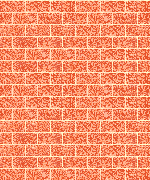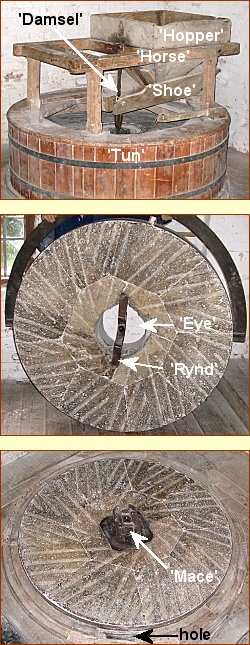 |
               |
Millstones |
|
 |
The millstones
in use, each 52.5" (133 cm) in diameter, are surrounded by a wooden
cover or 'tun', with the 'horse' supporting the 'hopper' and 'shoe'.
When operated commercially, grain fell from a grain bin in the Garner,
through a chute into the 'hopper', then slowly fed into the grain
'shoe'. This is agitated by the 'damsel', an iron rod located on the top
of the 'rynd'. Grain shaken from the 'shoe' falls into the central 'eye'
of the upper or 'runner' stone to be milled into wholemeal flour as it
moves to the outer edge of the stones. |
| The middle
picture shows the 'runner' stone being held on edge by the stone
crane. It enables stones, weighing up to a ton, to be lifted and
inverted to clean or dress the stone. The 'runner' and the 'bed' stone
are 'French' stones, each created from a number of pieces of hard
flint-like stone, or burrs, that were quarried near Paris. Specialised
stone masons would select a number of burrs before cutting them to
produce the millstones, holding them together by circular iron bands and
plaster of paris. The iron 'bar' or 'rynd' across the central 'eye' fits
over the 'mace' on the stone spindle, balanced on the pivot point of the
spindle, and turns the stone as the spindle rotates. Before being used,
a new runner stone needs to be balanced to run smoothly by placing small
lead weights into shallow holes in the top plaster surface. This runner
stone is made from thirteen burrs with four inner and nine outer pieces.
Many stones are made using more burrs, the open runner stone on the
Stone Floor being made from 24 burrs. |
| The bottom
picture shows the bed stone, fixed in position on the Stone Floor, and
surrounded by the close-fitting wooden skirting. A hole in the skirting,
but inside the surrounding 'tun', allows the meal produced by the
millstones to fall down a chute to the Meal
Bagging area on the floor below. The stone spindle protrudes through
the center of the bed stone and is fitted with the thick cast-iron 'H'
shaped 'mace', kept in position by the weight of the runner stone. The
spindle emerges through the mace to form the pivot point upon which the
'rynd' and runner stone rest. This bed stone is made from four inner and
eight outer burrs. |


